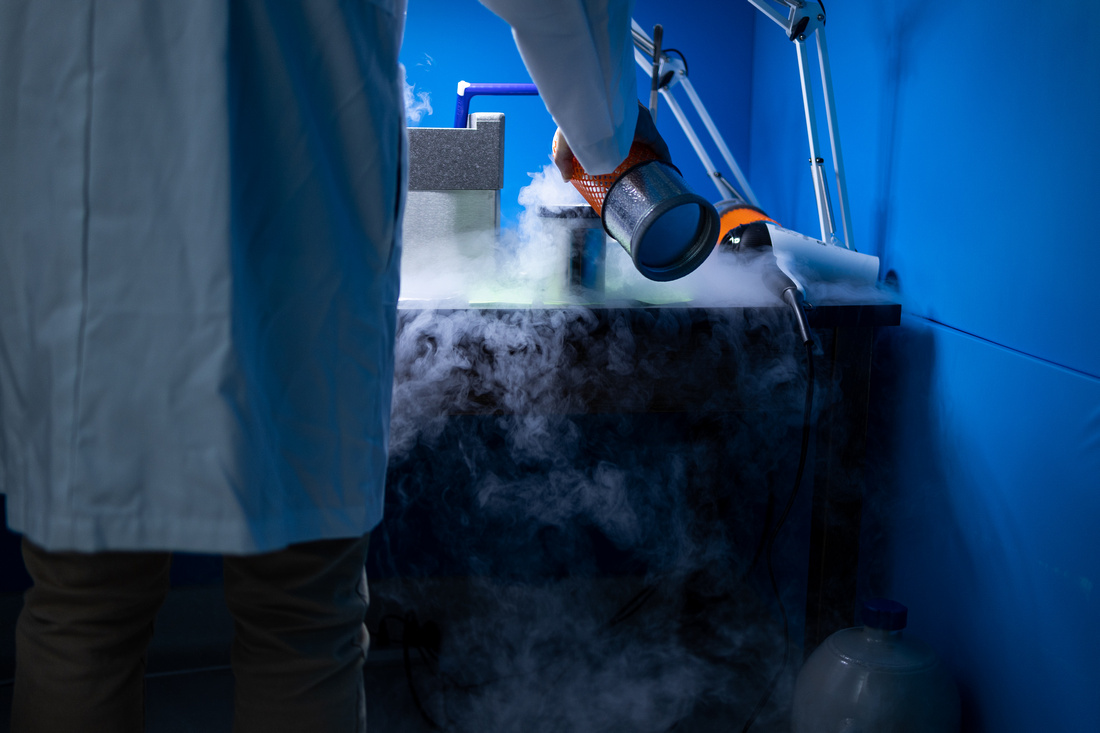Cryo-EM technology brings the study of tumors to a molecular level


UT Health San Antonio is investing $5 million over the next three years in cryo-electron microscopy technology, or cryo-EM, adding a powerful new tool to help solve disease riddles at the molecular level.
The technology will help investigators of the Mays Cancer Center study tumors and help researchers of the Greehey Children’s Cancer Research Institute to study childhood cancers.
Adding next-level research capacity
When physicians observe or hear of symptoms in their patients, they order CT scans, MRIs or other types of imaging analysis to understand the causes.
Clinical imaging, however, does not illuminate the vast machinations of life that occur deeper within, at the Lilliputian level of individual proteins and other molecules. Chain reactions in this tiny domain determine whether good health continues, or diseases begin.
To explore how the reactions foster disorder, scientists must acquire images with state-of-the-art instruments capable of ultra-high resolution so they can employ statistical models to work out molecular structures. The overall analysis can yield sites of disease susceptibility that can be targets for drug therapies.
UT Health San Antonio has taken a major step forward in its capacity for such advanced research with its cryo-EM investment.
Cryo-EM is complementary to existing structural biology technologies at UT Health San Antonio. X-ray crystallography, for example, exposes a protein crystal to X-rays, diffracting the X-ray beam in directions according to the protein’s structure. Nuclear magnetic resonance spectroscopy, meanwhile, demonstrates behavior of an atom nucleus when it is placed in a powerful magnetic field.
Cryo-EM visualizes proteins that are extremely difficult to image using other techniques, said Elizabeth Wasmuth, PhD, assistant professor of biochemistry and structural biology. She joined UT Health San Antonio in 2022 after participating in cryo-EM studies of prostate cancer conducted at multiple institutions in New York.
“This is the level of resolution that the techniques and tools of structural biology allow us to see about molecules inside cells, inside our bodies. Cryo-EM adds a powerful new dimension to our other methods,” Wasmuth said. “So, basically, it is like being able to see a dime on the surface of the moon.”
Some protein targets are too small to be visualized by existing techniques or have flexible, wiggly regions that impede crystal formation, Wasmuth said. Cryo-EM flash-freezes proteins on thin layers of ice within milliseconds and barrages them with electron beams, generating biologically useful information.
“Having a cryo-EM system will allow us to observe drug targets that couldn’t be visualized by the other methods,” Wasmuth said.
“The second week the cryo-EM facility became functional, we were able to solve the structure of a complex of proteins involved in DNA damage repair at impressively high resolution. I am confident that this tool is going to transform structural biology research here like we haven’t seen before.”
Pursuing the science that will cure disease
Cryo-EM as a scientific tool has boomed in the last decade due to advances in technology. Better microscopes, better optics and better computer programming have allowed new discoveries.
UT Health San Antonio’s cryo-EM system, a Glacios outfitted with a cutting-edge detector (Falcon 4) and energy filter (Selectris), will help investigators of the Mays Cancer Center study tumors. It will help investigators of the Glenn Biggs Institute for Alzheimer’s and Neurodegenerative Diseases study dementia. It will help faculty of the Sam and Ann Barshop Institute for Longevity and Aging Disorders to study age-related diseases. And, among many other disciplines and applications at UT Health San Antonio, it will also help researchers of the Greehey Children’s Cancer Research Institute to study childhood cancers.
“UT Health Science Center at San Antonio is a premier biomedical research enterprise because of its commitment to these types of investments,” said Jennifer Sharpe Potter, PhD, the institution’s vice president of research.
“This acquisition reflects our commitment to making San Antonio a biomedicine hub for the United States and the world. The types of visualizations and the questions that this technology advances are investments in the long-term improvement of human health.”
Surface imaging system provides sub-millimeter accuracy
After receiving her bachelor’s degree in physics from Colorado College, UT Health San Antonio Class of 2022 PhD graduate Victoria Bry discovered the field of medical physics, which is the application of physics in medicine, predominantly in the areas of nuclear medicine, radiology and radiation oncology.
Under the mentorship of Karl Rasmussen, PhD, assistant professor in the Department of Radiation Oncology, Bry’s graduate didactic training and research included work at the Mays Cancer Center with physicists, medical doctors, radiation therapists, dosimetrists and others.
Her research focused on a technique called surface guided imaging, a technology that uses light to create motion maps of the external surface of a patient’s body. Surface imaging cameras are adjusted and customized based on reflections to provide 3D information about the patient’s position before and during radiation delivery, allowing for accurate delivery of the prescribed treatment.
“Our research has demonstrated that the surface imaging system at the Mays Cancer Center has comparable accuracy to X-ray imaging and it is advantageous because it does not require additional imaging radiation. This system provides us with sub-millimeter accuracy about the positioning of patient’s surface that we have not had in the past, allowing us to deliver treatments more confidently,” Bry said.
Bry’s dissertation work investigated the accuracy and limitations of surface imaging for its implementation for stereotactic radiosurgery. Her work also investigated an unexplored method to calibrate the surface imaging cameras for different skin tones to ensure optimal use for all populations.
Read more stories from our 2022 Annual Report.

 Close
Close